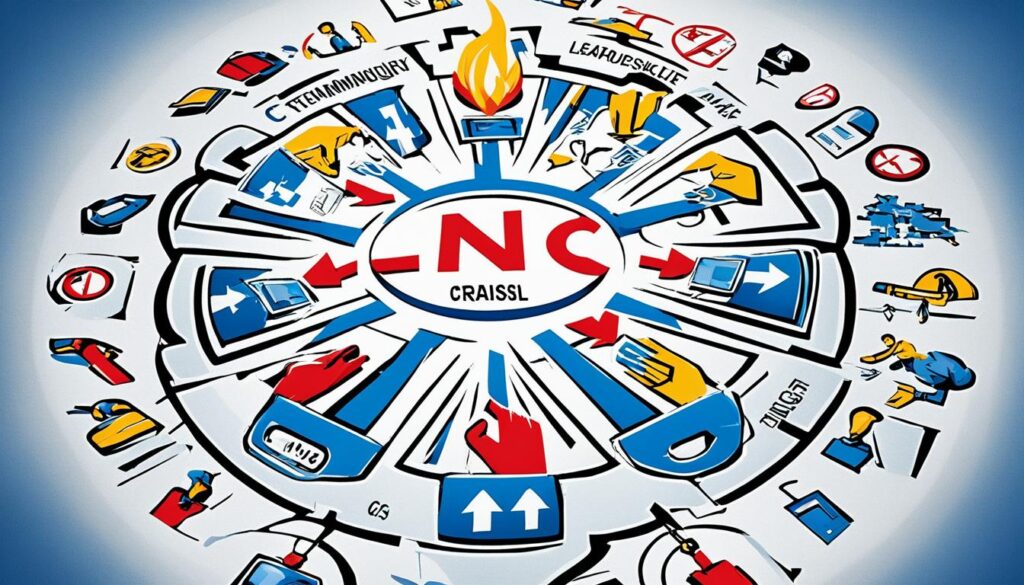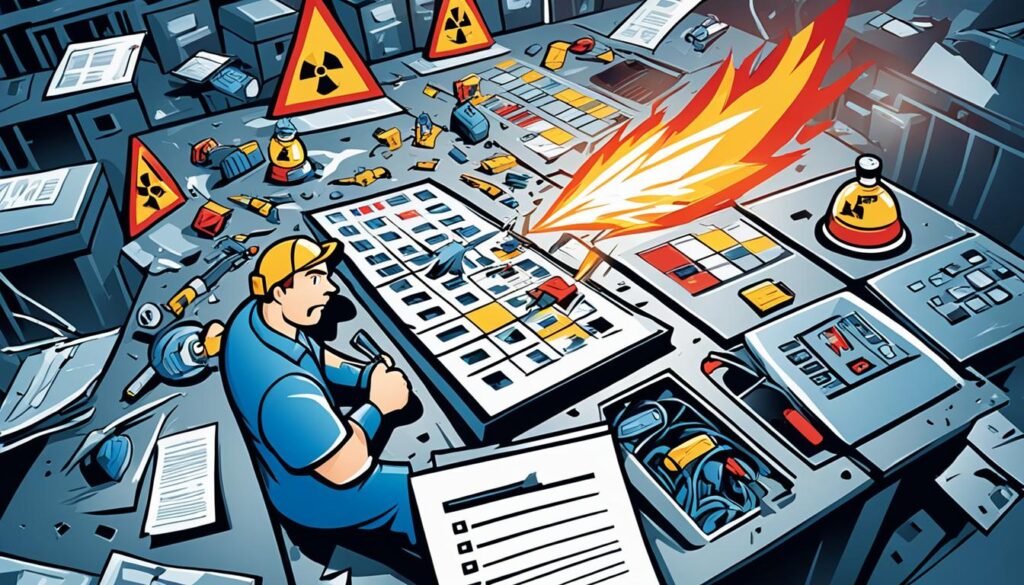Did you know that IPTV (Internet Protocol Television) is playing a crucial role in disaster management and emergency response? In times of crises, having a reliable and efficient communication system is essential for ensuring the safety and well-being of affected communities. IPTV offers a powerful solution that enables seamless crisis communication, disaster recovery, and effective crisis response.
With IPTV, emergency responders and organizations can quickly disseminate critical information to a wide audience, providing real-time updates, instructions, and guidance during emergencies. Whether it’s a natural disaster, a public safety incident, or any other crisis, IPTV enables efficient communication that can save lives and mitigate the impact of disasters.
In this article, we explore the various ways IPTV is revolutionizing disaster management and crisis response. From emergency broadcast systems to tailored messaging solutions, IPTV offers a range of capabilities that enhance preparedness and streamline communication in times of crisis. Join us as we delve into the world of IPTV and its invaluable role in disaster preparedness and response.
Key Takeaways:
- IPTV has become an essential tool in disaster management and emergency response.
- It enables efficient communication, real-time updates, and critical information dissemination during crises.
- IPTV enhances preparedness, streamlines communication, and mitigates the impact of disasters.
- Emergency broadcast systems and tailored messaging solutions are key features of IPTV in disaster management.
- IPTV plays a crucial role in saving lives and ensuring the safety of affected communities.
Importance of Connectivity in Emergency Management Operations
When it comes to managing the outcomes of humanitarian disasters, communication networks and connectivity play a crucial role. In emergency environments where existing communications infrastructures have been compromised, the need for seamless and reliable connectivity becomes even more essential.
Managed ad-hoc networks and decentralized wireless networks like MANETs have emerged as vital solutions for connectivity in emergency management. These networks enable mission-critical video streaming and the deployment of ISR (Intelligence, Surveillance, and Reconnaissance) technology to gather real-time information and facilitate situational awareness.
One key aspect of connectivity in emergency management is the establishment of multi-disciplinary fusion centers. These centers bring together federal, state, and local government agencies, creating a shared commitment to effective crisis response. Through multi-disciplinary collaboration, fusion centers foster seamless systems that integrate information from various sources, enabling swift and coordinated actions.
In order for connectivity to be effective, distributed leadership is crucial. Emergency management requires leaders at different levels to guide and coordinate operations. By distributing leadership responsibilities, organizations can tap into the diverse expertise and leverage the strengths of their teams. This distributed leadership model also encourages a culture of automation, standardization, and ad-hoc collaboration, ensuring effective digital collaboration in highly fluid crisis management missions.
The Role of Managed Ad-Hoc Networks
Managed ad-hoc networks play a critical role in emergency management. These networks provide connectivity in situations where traditional infrastructures are unavailable or unreliable. By establishing ad-hoc networks, emergency responders are able to quickly set up communication systems, ensuring seamless connectivity for information sharing, coordination, and decision-making.
Through managed ad-hoc networks, emergency management teams can harness the power of modern technologies and tools. This includes mission-critical video streaming, which enables real-time visual information sharing for better situational awareness. ISR technology, such as drones and surveillance cameras, can also be integrated into these networks, providing valuable insights and intelligence.
An Overview of Fusion Centers
Multi-disciplinary fusion centers are key components of effective connectivity in emergency management. These centers serve as coordination hubs, bringing together representatives from various government agencies, including law enforcement, public health, disaster response, and transportation. By combining their expertise and resources, fusion centers provide a comprehensive and integrated approach to crisis management.
Through fusion centers, information from different sources can be analyzed, synthesized, and disseminated to relevant stakeholders, allowing for a more accurate understanding of the situation at hand. This enhanced information integration enables better threat prevention and response, leading to more effective crisis management missions.
Overall, the importance of connectivity in emergency management operations cannot be overstated. From managed ad-hoc networks to multi-disciplinary fusion centers, the seamless flow of information and collaboration is essential for efficient crisis response. By embracing distributed leadership, automation, standardization, and ad-hoc collaboration, emergency management organizations can leverage connectivity to maximize their effectiveness in highly fluid situations.
| Benefits of Connectivity in Emergency Management | Examples |
|---|---|
| Real-time information sharing | Mission-critical video streaming |
| Enhanced situational awareness | Integrated ISR technology |
| Coordinated actions | Managed ad-hoc networks |
| Improved decision-making | Multi-disciplinary fusion centers |
| Efficient crisis response | Distributed leadership |
Technology and Operational Coordination in Disaster Management
When it comes to disaster management, technology standardization and operational coordination are essential. Companies like VITEC, a leading provider of IP video streaming and encoding solutions, recognize the critical role of technology in effective emergency response. The emphasis is on multi-disciplinary fusion centers that integrate information from national and local sources to prevent and respond to threats and hazards.
Multi-disciplinary fusion centers serve as the linchpin of information integration in disaster management. By integrating data from various sources, these fusion centers enable a comprehensive and coordinated approach to threat prevention and response. The seamless exchange of information helps emergency management teams make informed decisions and take proactive measures to mitigate the impact of emergencies.
The fusion centers also foster a culture of collaboration among different agencies involved in emergency management missions. This collaboration is crucial for efficient and effective response, as it allows for the sharing of resources, expertise, and best practices. It also promotes standardization and automation in emergency management processes, ensuring a unified approach across different jurisdictions.
Automation and standardization play a vital role in streamlining emergency management operations. By automating routine tasks and processes, emergency management teams can free up valuable time and resources to focus on critical aspects of disaster response. Standardized procedures and protocols also enable smoother coordination among different agencies and stakeholders, facilitating cohesive and efficient emergency management.
The integration of technology, operational coordination, and collaboration in disaster management is key to effective emergency response and ensuring the safety and well-being of communities. By leveraging video encoding solutions and other advanced technologies, organizations like VITEC are at the forefront of driving innovation in emergency management, enabling more efficient and coordinated response efforts.
Benefits of Technology and Operational Coordination in Disaster Management
Effective technology standardization, operational coordination, and collaboration in disaster management offer numerous benefits, including:
- Improved Information Integration: Fusion centers enable the seamless integration of information from various sources, providing a comprehensive view of threats and hazards.
- Enhanced Threat Prevention and Response: Multi-disciplinary fusion centers facilitate proactive measures to prevent and respond to emergencies by leveraging timely and accurate information.
- Streamlined Operations: Automation and standardization help streamline emergency management processes, enabling more efficient resource allocation and response coordination.
- Collaborative Decision-Making: Collaboration among different agencies and stakeholders fosters a culture of shared knowledge and expertise, leading to better-informed decision-making during emergencies.
- Optimized Resource Utilization: By working together and sharing resources, emergency management teams can optimize the use of personnel, equipment, and other assets.
With technology and operational coordination serving as the backbone of effective disaster management, the future of emergency response holds great promise. By harnessing the power of innovative solutions and collaborative approaches, organizations can better protect communities and mitigate the impact of emergencies.

Distributed Leadership and Collaboration in Emergency Situations
When it comes to emergency situations, effective engagement of the emergency management community is crucial. That’s where distributed leadership plays a vital role. By allowing first responder agencies from different jurisdictions to assemble and collaborate, distributed leadership enables the optimization of Information, Surveillance, and Reconnaissance (ISR) solutions for specific emergency scenarios.
In this context, units like the Army and Air Force National Guard and Reserve have proven to be invaluable. Their ability to co-create and configure ISR solutions tailored to the unique demands of each emergency or catastrophe enhances the overall effectiveness of crisis management efforts. With fluid situations requiring quick decision-making, automation and standardization are key, ensuring a cohesive approach and seamless collaboration among first responders.
By leveraging distributed leadership, emergency management agencies can optimize the use of automation, standardization, and collaboration in crisis management. This approach promotes efficient communication and coordination, allowing for a faster and more coordinated response to emergencies.
Benefits of Distributed Leadership in Emergency Management
The concept of distributed leadership offers several benefits in emergency situations:
- Promotes Collaboration: Distributed leadership encourages collaboration among first responder agencies, fostering a culture of cooperation and knowledge sharing.
- Enhances Expertise: By bringing together professionals from various agencies, distributed leadership allows for the exploration of diverse perspectives and expertise, leading to more informed decision-making.
- Optimizes Resource Allocation: Collaboration among different agencies enables efficient resource allocation, ensuring that the right resources are deployed at the right time and in the right place.
- Boosts Adaptability: Distributed leadership enables a flexible and adaptive approach to emergency situations. This agility ensures a rapid response and the ability to adjust strategies as the situation evolves.
Overall, distributed leadership in emergency management empowers first responder agencies to act as a cohesive force, working towards the common goal of saving lives and minimizing the impact of disasters.

| Advantages of Distributed Leadership | Benefits |
|---|---|
| Promotes Collaboration | Encourages cooperation and knowledge sharing among first responder agencies |
| Enhances Expertise | Fosters diverse perspectives and expertise, leading to more informed decision-making |
| Optimizes Resource Allocation | Enables efficient deployment of resources |
| Boosts Adaptability | Allows for a flexible and adaptive approach to emergency situations |
Server Disaster Recovery Plan – Mitigating the Effects of Disasters
A server disaster recovery plan is essential for any organization to mitigate the effects of disasters on hosting servers and ensure a quick and efficient recovery process. By having a well-designed plan in place, businesses can proactively prepare for various types of disasters, including DDoS attacks, natural disasters, power shortages, and human errors.
One of the primary objectives of a server disaster recovery plan is to establish clear goals and define recovery time objectives (RTO) and recovery point objectives (RPO). These objectives set the timeline and level of data loss that the organization is willing to accept during the recovery process.
The plan should also include the assignment of personnel roles, ensuring that there is a clear understanding of responsibilities and who will execute specific recovery tasks. By clearly defining roles, the recovery process can be streamlined and efficient.
Listing applications and inventory is another crucial aspect of a server disaster recovery plan. This helps identify the critical applications and systems that need immediate attention during the recovery process.
Identification of sensitive documents and data is imperative to safeguarding important information. The plan should clearly outline how sensitive data should be handled and recovered to minimize potential risks.
In addition to local backups, creating offshore backups is essential for disaster recovery purposes. Offsite backups provide an extra layer of protection in case the primary data center is affected during a disaster event.
Mapping out disaster recovery sites is a critical step in the planning process. Identifying alternative locations where servers can be restored helps ensure that there are appropriate resources available to support the recovery efforts.
Formulating a disaster response procedure is crucial for guiding employees on what actions to take during and after a disaster event. This procedure should include steps for assessing the situation, communicating with stakeholders, and initiating the recovery process.
A communication plan is fundamental for effective disaster response. It outlines how information will be disseminated to internal and external stakeholders, ensuring clear and timely communication throughout the recovery process.
Regular testing and updates are vital for maintaining the effectiveness of the server disaster recovery plan. Conducting tests allows organizations to identify any gaps or weaknesses in the plan and make the necessary adjustments to ensure its efficiency.
By implementing a comprehensive server disaster recovery plan, organizations can mitigate the effects of disasters, recover quickly and efficiently, and minimize potential downtime and data loss.

| Benefits of a Server Disaster Recovery Plan | Challenges of Implementing a Server Disaster Recovery Plan |
|---|---|
|
|
What is a Server Disaster Recovery Plan?
A server disaster recovery plan is a set of guidelines and strategies aimed at mitigating the effects of disasters on hosting servers. It covers various types of disasters, including DDoS attacks, natural disasters, power shortages, and human errors. The primary objective of a server disaster recovery plan is to recover quickly and efficiently, minimizing the negative effects and ensuring little downtime.
The plan should include:
- Clear goals to guide the recovery process
- Recovery time objectives (RTO) and recovery point objectives (RPO) for establishing recovery timelines
- Clearly defined personnel roles and responsibilities
- Application inventory to prioritize system recovery
- Identification of sensitive documents and data for secure recovery
- Offshore backups to minimize data loss
- Mapping out disaster recovery sites for seamless transition
- Establishment of response procedures for efficient management of the recovery process
- Formulation of a communication plan to keep stakeholders informed
Regular testing and updates are essential to ensure the plan’s effectiveness and minimize any potential gaps or vulnerabilities in the recovery process.

| Disaster Types | Challenges |
|---|---|
| DDoS attacks | Overwhelming server resources, causing service disruption |
| Natural disasters | Destruction or damage to servers and infrastructure |
| Power shortages | Loss of electricity impacting server operations |
| Human errors | Mistakes or accidents that compromise server functionality |
A server disaster recovery plan plays a critical role in ensuring business continuity and minimizing the impact of disasters. By implementing a robust plan, businesses can recover quickly and efficiently, reducing both financial losses and reputational damage.
When is a Server Disaster Recovery Plan Useful to Have?
A server disaster recovery plan is a crucial asset in various situations where different types of disasters can cause damage or interruptions to hosting servers. While it is often associated with cataclysmic events, such as natural disasters, its applicability extends to a wide range of scenarios.
One such scenario is the threat of DDoS attacks, where servers can be overwhelmed by malicious traffic, leading to service disruptions and potential data breaches. A server disaster recovery plan helps organizations minimize the negative effects of these attacks and ensure a swift recovery.
Natural disasters, such as hurricanes, earthquakes, or floods, also pose significant risks to server infrastructure. By having a comprehensive disaster recovery plan in place, organizations can minimize downtime and quickly resume operations, even in the face of such catastrophic events.
Server failures resulting from power shortages, hardware malfunctions, or network failures can also have a severe impact on businesses. A well-designed recovery plan helps organizations mitigate these risks and minimize the negative effects on their operations, ensuring continuity and reducing financial losses.
Implementing a server disaster recovery plan is a proactive measure that allows organizations to be prepared for unforeseen circumstances. By identifying potential risks and vulnerabilities, companies can take appropriate measures to safeguard their servers and data, thereby minimizing the impact of disasters and ensuring business continuity.

| Disaster | Effect on Hosting Servers |
|---|---|
| DDoS Attacks | Service disruptions, potential data breaches |
| Natural Disasters | Downtime, infrastructure damage |
| Power Shortages | Server failures, data loss |
| Hardware Malfunctions | Data corruption, service disruptions |
| Network Failures | Communication breakdown, service interruptions |
Having a server disaster recovery plan not only helps organizations recover quickly and efficiently but also gives them the confidence to navigate through unforeseen challenges. Remember, preparedness is key, and a robust recovery plan ensures that businesses can continue operating despite the various disasters that may come their way.
Elements of an Effective Server Disaster Recovery Plan
An effective server disaster recovery plan is crucial for mitigating the effects of disasters on hosting servers and ensuring quick and efficient recovery. The plan should encompass various elements that contribute to preparedness and resilience in the face of unexpected events.
1. Clearly Defined Recovery Time Objectives (RTOs) and Recovery Point Objectives (RPOs)
In developing a server disaster recovery plan, it is important to establish specific recovery time objectives (RTOs) and recovery point objectives (RPOs). RTOs define the maximum acceptable downtime, while RPOs determine the maximum acceptable data loss. These metrics provide measurable targets for recovery efforts and help prioritize critical systems and data.
2. Detailed IT Asset Inventories
Creating comprehensive IT asset inventories is essential for an effective recovery plan. These inventories should include detailed information about hardware, software, network infrastructure, and other critical components. Having a clear understanding of the IT assets enables efficient recovery and replacement processes.
3. Assigned Personnel Roles
Assigning specific roles and responsibilities to designated personnel is crucial for ensuring a coordinated response during a disaster. Each team member should have a clear understanding of their roles and be trained to execute their responsibilities effectively. This promotes efficient decision-making and problem-solving.
4. Identification of Sensitive Documents and Data
Identifying and safeguarding sensitive documents and data is a critical aspect of disaster recovery planning. This involves conducting a thorough assessment of data vulnerabilities, classifying sensitive information, and implementing appropriate security measures. By protecting valuable assets, organizations can minimize the impact of data breaches or loss.
5. Disaster Recovery Drills
Regular disaster recovery drills are essential for testing the effectiveness of the plan and identifying areas for improvement. These drills simulate real-life disaster scenarios and provide an opportunity to gauge the response procedures, validate backups, and assess the overall readiness of the organization.
6. Clear Goals
Establishing clear and achievable goals is essential for guiding the recovery process. These goals should align with the organization’s priorities and take into account the RTOs and RPOs. By setting specific objectives, organizations can focus their resources and efforts efficiently.
7. Response Procedures
A well-defined set of response procedures ensures a structured and organized approach to disaster recovery. These procedures outline the steps to be taken during various stages of recovery, including incident identification, communication protocols, resource allocation, and system restoration. Having documented response procedures minimizes confusion and enables a timely recovery.
8. Communication Plan
Effective communication is vital during a disaster recovery situation. Developing a communication plan that includes channels, contact information, and escalation procedures helps facilitate timely and accurate information sharing among team members, stakeholders, and external parties. Robust communication channels enable swift decision-making and promote collaboration.
Continual Testing and Updates
An effective server disaster recovery plan is a dynamic document that requires regular testing and updates. Technology and potential threats are constantly evolving, making it essential to review and revise the plan periodically. Regular testing ensures that the plan remains effective and aligns with the organization’s changing needs.
12 Step Server Disaster Recovery Plan Template
When it comes to preparing for a server disaster, having a comprehensive recovery plan is essential. A well-designed server disaster recovery plan ensures that your organization can respond quickly and effectively in the event of an unforeseen catastrophe. By following a 12-step template, you can establish a solid foundation for mitigating the effects of a disaster and facilitating a rapid recovery.
- Plan for Different Types of Disasters: Consider various scenarios such as natural disasters, power outages, cyberattacks, or hardware failures. Each type of disaster requires a specific response to minimize downtime and data loss.
- Define Goals: Clearly outline the objectives you aim to achieve during the recovery process. These goals will serve as a reference point for evaluating the success of your recovery efforts.
- Determine Recovery Time Objectives (RTO) and Recovery Point Objectives (RPO): Set specific targets for how quickly you aim to restore operations (RTO) and how much data loss is acceptable (RPO) during the recovery process.
- Assign Personnel Roles: Identify the individuals responsible for executing each step of the recovery plan. Clearly define their roles and provide training, if necessary.
- List Applications and Inventory: Compile a comprehensive inventory of all applications, systems, and hardware that are critical for maintaining operations.
- Identify Sensitive Documents and Data: Determine the critical documents and data that must be protected and prioritize their recovery in the event of a disaster.
- Make Offshore Backups: Implement a strategy for making regular backups of your data and storing them in offsite locations, preferably in geographically distant areas unlikely to be affected by the same disaster.
- Map Out Disaster Recovery Sites: Identify alternative sites where your operations can be temporarily relocated in the event of a catastrophic failure at your primary location.
- Create a Disaster Response Procedure: Develop a step-by-step procedure for responding to a disaster. This should include initial response actions, resource allocation, and escalation processes.
- Formulate a Communication Plan: Establish a communication plan detailing how information will be disseminated to stakeholders, employees, and customers during the recovery process.
- Test the Plan: Regularly test your server disaster recovery plan to ensure that it is effective and executable. This includes validating the RTO and RPO targets and assessing the readiness of personnel.
- Regularly Update the Plan: Keep your recovery plan up to date by revisiting it periodically. As your technology landscape evolves, the plan should be adjusted to reflect the changes in your infrastructure and critical data.
| Type of Plan | Advantages |
|---|---|
| Data Center DRP | Provides a dedicated physical infrastructure for disaster recovery, offering localized control and faster recovery times. |
| Cloud DRP | Offers scalable and flexible solutions, allowing for easy replication and recovery of both data and applications. |
| Hybrid DRP | Combines the benefits of both data center and cloud solutions, providing a balanced approach that meets specific business needs. |
By following this 12-step server disaster recovery plan template, you can ensure that your organization is well-prepared to face any disaster. Regular testing and updates will help maintain the plan’s effectiveness over time. Remember, a solid recovery plan is the key to minimizing downtime, protecting sensitive data, and ensuring business continuity in the face of adversity.
3 Types of Server Disaster Recovery Plans
When it comes to protecting your hosting servers from disasters, having a robust server disaster recovery plan (DRP) is essential. There are three main types of server DRPs that you can implement based on your business needs and hosting methods: data center DRP, cloud DRP, and hybrid DRP.
Data Center Disaster Recovery Plan (DRP)
A data center DRP involves creating a comprehensive plan to recover your servers in the event of a disaster. This plan typically includes backup systems, offsite storage facilities, and redundant infrastructure to minimize downtime and ensure business continuity. A data center DRP is suitable for businesses that rely heavily on their on-premises servers and have the resources to maintain and manage their own data center.
Cloud Disaster Recovery Plan (DRP)
A cloud DRP involves utilizing the infrastructure and services provided by a cloud service provider to protect your servers and data from disasters. With a cloud DRP, your servers are replicated in the cloud, allowing for quick and efficient recovery in the event of a disaster. Cloud DRPs offer scalability, flexibility, and cost-efficiency, making them an ideal choice for businesses that want to outsource their disaster recovery efforts and leverage the advantages of cloud computing.
Hybrid Disaster Recovery Plan (DRP)
A hybrid DRP combines elements of both data center and cloud DRPs, allowing businesses to take advantage of the benefits offered by both approaches. With a hybrid DRP, critical applications and data are replicated both on-premises and in the cloud, providing a high level of redundancy and ensuring resilience in the face of disasters. Hybrid DRPs are suitable for businesses that have specific requirements for data locality, compliance, or performance.
Choosing the right server disaster recovery plan depends on several factors, including your business needs and the hosting methods you use. Each approach offers distinct advantages and allows you to tailor your disaster recovery strategies to align with your organization’s requirements. Whether you opt for a data center DRP, cloud DRP, or hybrid DRP, implementing a comprehensive disaster recovery approach is crucial in safeguarding your data and minimizing the impact of disasters on your business.
Conclusion
In conclusion, IPTV plays a crucial role in disaster management by providing a reliable and efficient communication platform during emergencies. It enables seamless crisis response and ensures that vital information reaches the affected parties in a timely manner. However, to ensure the continuity of IPTV services and minimize the impact of disasters on hosting servers, a comprehensive server disaster recovery plan is essential.
By implementing a disaster recovery plan, organizations can effectively mitigate the effects of various disasters such as DDoS attacks, natural disasters, power shortages, and human errors. The plan should include clearly defined goals, recovery time objectives (RTOs), recovery point objectives (RPOs), personnel roles, application inventory, sensitive document identification, offsite backups, disaster recovery sites, response procedures, and a communication plan. These elements work together to facilitate quick and efficient recovery, minimizing downtime and ensuring business continuity.
Regular testing and updates are crucial for maintaining the effectiveness of the server disaster recovery plan. By regularly testing the plan and making necessary updates, organizations can identify and address any vulnerabilities or gaps, improving their preparedness and response capabilities. This ongoing effort ensures that the plan remains up-to-date and aligned with the evolving needs of the business and the changing landscape of disasters.
In summary, IPTV and a well-designed server disaster recovery plan go hand in hand in disaster management. Together, they enable organizations to mitigate the effects of disasters, recover efficiently, and maintain effective communication channels during emergencies. By prioritizing preparedness and regularly updating the plan, organizations can enhance their resilience and ensure the continuity of their operations in the face of unforeseen crises.
FAQ
What is IPTV Disaster Management?
How can IPTV be used for disaster preparedness?
What are the benefits of using IPTV for disaster response?
What is a server disaster recovery plan?
When is a server disaster recovery plan useful to have?
What are the elements of an effective server disaster recovery plan?
What is a 12-step server disaster recovery plan template?
What are the types of server disaster recovery plans?






